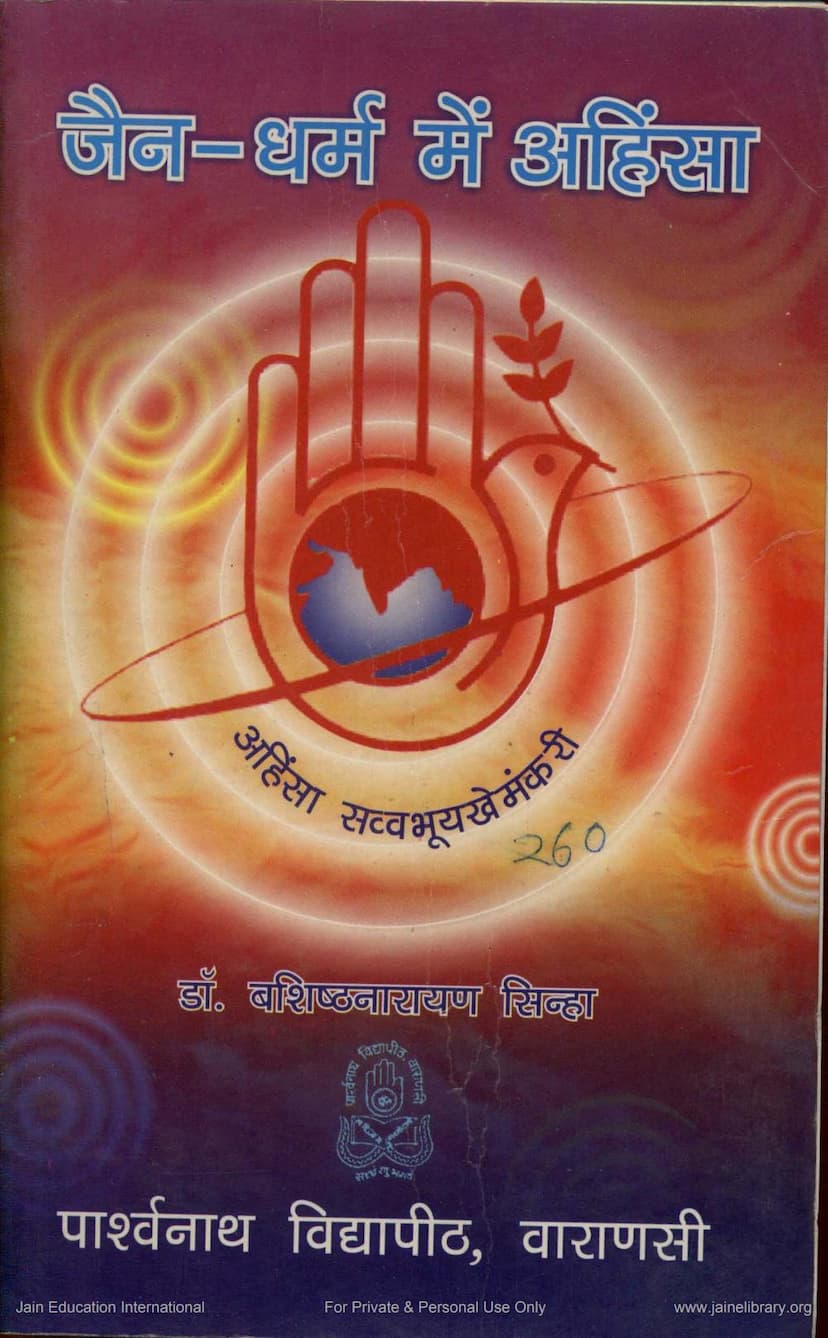Jain Dharma Me Ahimsa
Added to library: September 2, 2025

Summary
Certainly! Here's a comprehensive summary of the Jain text "Jain Dharma mein Ahimsa" by Dr. Bashistha Narayan Sinha, based on the provided pages:
Book Title: Jain Dharma mein Ahimsa (Ahimsa in Jainism) Author: Dr. Bashistha Narayan Sinha Publisher: Parshwanath Shodhpith Varanasi Language: Hindi
This book, a second edition published in 2002, is a detailed academic work exploring the concept of Ahimsa (non-violence) within Jainism and its comparative presence in other traditions. The author, Dr. Bashistha Narayan Sinha, a former research scholar at Parshwanath Shodhpith, delves into the philosophical, ethical, and practical dimensions of Ahimsa.
Key Themes and Structure:
The book is structured into six chapters, each dedicated to a specific aspect of Ahimsa:
-
Chapter 1: Ahimsa in Non-Jain Traditions (जैनेतर परम्पराओं में अहिंसा): This chapter provides a comparative study of Ahimsa in various religious and philosophical traditions beyond Jainism. It traces the presence and evolution of the concept in:
- Vedic Tradition: Examining its roots in the Vedas, Upanishads, Smritis, Mahabharata, and Bhagavad Gita. It notes the presence of sacrifice and meat-eating in early Vedic practices but highlights the development of Ahimsa as a moral principle in later texts and philosophical schools like Vedanta.
- Brahmanism: Discusses the influence of Brahmanical philosophy.
- Buddhism: Details the prominent role of Ahimsa and compassion in Buddhist teachings, emphasizing its centrality.
- Other World Religions: Briefly touches upon Ahimsa in Sikhism, Zoroastrianism, Judaism, Christianity, Islam, Taoism, Confucianism, Sufism, and Shintoism, identifying the varying degrees of emphasis and interpretation.
-
Chapter 2: Jain Literature on Ahimsa (अहिंसा-सम्बन्धी जैन साहित्य): This chapter focuses on the textual sources within Jainism that expound on Ahimsa. It surveys key Jain scriptures, including Agamas like Acharanga Sutra, Sutrakritanga Sutra, Samavayanga, Nandi Sutra, Bhagavati Sutra, Uttaradhyayana Sutra, and others, explaining how Ahimsa is interwoven into the fabric of Jain philosophy and practice across these texts.
-
Chapter 3: Ahimsa from the Jain Perspective (जैन दृष्टि से अहिंसा): This is considered the core of the book. It offers a deep philosophical analysis of Ahimsa in Jainism, covering:
- Definition of Violence (हिंसा की परिभाषा): Violence is defined as the harm caused to living beings through the negligence of the senses and mind (pramatta yoga).
- Nature and Origin of Violence (हिंसा का स्वरूप, उत्पत्ति एवं भेद): It explores the origins of violence stemming from passions (kashayas) like anger, pride, delusion, and greed, leading to various types of violence.
- Types and Causes of Violence: The text details the classification of violence based on the living beings harmed (six vitalities - six kaya), the means of violence (mind, speech, body), the intention (intent, execution, approval), and the intensity of passions. It lists numerous names and forms of violence.
- Ahimsa (Non-Violence): The chapter defines Ahimsa as the absence of violence in thought, word, and deed, emphasizing its multifaceted nature, including compassion (daya), charity (dana), and the cultivation of virtues. It lists many synonyms for Ahimsa, highlighting its comprehensive scope.
-
Chapter 4: Jain Conduct and Ahimsa (जैनाचार और अहिंसा): This chapter examines the practical application of Ahimsa in the daily lives of Jain ascetics (Shravakas) and monks (Shramanas). It details the strict codes of conduct, including:
- Anuvratas (Minor Vows): The basic vows undertaken by householders, focusing on limiting harm to living beings, controlling speech, not stealing, limiting possessions, and sexual restraint. It elaborates on the concept of "Sthula Prana-ati-paata Viramana" (abstinence from gross violence) and its various nuances for lay followers.
- Guna Vratas (Qualitative Vows): Vows that enhance the minor vows, like spatial restrictions (Digvrata), limiting consumption (Bhoga-upbhoga Parimana), and avoiding causeless harm (Anartha-danda-viramana).
- Shiksha Vratas (Training Vows): Vows like Samayika (equanimity), Deshavakashika (temporal and spatial restrictions), Paushadha (fasting), and Atithi Samvibhakta (charity to monks) that refine the practice.
- Shramanachara (Monastic Conduct): The rigorous practices of Jain monks, including the five Mahavratas (great vows), control of senses, meticulous care in movement (Irya Samiti), speech (Vak Samiti), conduct (Cara Samiti), acceptance of alms (Eshana Samiti), and excretion (Ucchara Samiti), along with the three controls (Guptis) of mind, speech, and body.
-
Chapter 5: Gandhian Ahimsa and Jain Ahimsa (गांधीवादी अहिंसा तथा जैन धर्म प्रतिपादित अहिंसा): This chapter critically compares Mahatma Gandhi's philosophy of Ahimsa with that of Jainism. It highlights the similarities in the core principles of non-violence, compassion, truth, and the spiritual aim. It also discusses differences, such as Gandhi's acceptance of certain unavoidable harms for human survival (like pest control) and his emphasis on political struggle through non-violent means (Satyagraha), which differs from the strictly individual spiritual liberation focus of Jain Ahimsa. It explores how Gandhi's Ahimsa was influenced by Jainism and other traditions.
-
Chapter 6: Conclusion (उपसंहार): This chapter summarizes the findings, reiterates the centrality of Ahimsa in Jainism, and provides a concluding perspective on its significance in comparative religious and ethical studies. It also briefly discusses the historical development and challenges faced by the principle of Ahimsa across different traditions and in modern times.
Overall Significance:
"Jain Dharma mein Ahimsa" is presented as a monumental and authentic research work that provides a scholarly exploration of Ahimsa in Jainism. The author's rigorous research, critical analysis, and comprehensive coverage of various religious traditions make this book a valuable contribution to the understanding of this fundamental ethical principle. The endorsements from esteemed scholars like Prof. Satkari Mookerjee and Prof. N. K. Devraj attest to its academic merit and significance. The book aims to illuminate the depth, breadth, and practical application of Ahimsa in Jainism and its dialogue with other philosophical and religious thought.